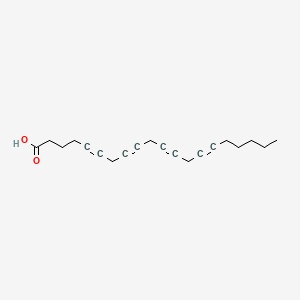| Clarke SD and Jump D |
Polyunsaturated fatty acids regulate lipogenic and peroxisomal gene expression by independent mechanisms. |
1997 |
Prostaglandins Leukot. Essent. Fatty Acids |
pmid:9250610
|
| Keller H et al. |
PPAR alpha structure-function relationships derived from species-specific differences in responsiveness to hypolipidemic agents. |
1997 |
Biol. Chem. |
pmid:9278144
|
| Leffler CW et al. |
Mechanisms of hypoxia-induced cerebrovascular dilation in the newborn pig. |
1997 |
Am. J. Physiol. |
pmid:9087608
|
| Ondrey FG et al. |
Decreased DNA synthesis in SCC-25 cells with ETYA and SC41661. |
1997 |
Adv. Exp. Med. Biol. |
pmid:9547598
|
| Oyekan A et al. |
Renal oxygenases: differential contribution to vasoconstriction induced by ET-1 and ANG II. |
1997 |
Am. J. Physiol. |
pmid:9249563
|
| Munaron L et al. |
Arachidonic acid mediates calcium influx induced by basic fibroblast growth factor in Balb-c 3T3 fibroblasts. |
1997 |
Cell Calcium |
pmid:9330788
|
| Stuhlmeier KM et al. |
The effect of 5,8,11,14-eicosatetraynoic acid on endothelial cell gene expression. |
1997 |
Eur. J. Pharmacol. |
pmid:9163568
|
| Ledwith BJ et al. |
Induction of cyclooxygenase-2 expression by peroxisome proliferators and non-tetradecanoylphorbol 12,13-myristate-type tumor promoters in immortalized mouse liver cells. |
1997 |
J. Biol. Chem. |
pmid:9013627
|
| Mufti NA and Shuler ML |
Possible role of arachidonic acid in stress-induced cytochrome P450IA1 activity. |
1996 Nov-Dec |
Biotechnol. Prog. |
pmid:8983209
|
| Villarroel A and Schwarz TL |
Inhibition of the Kv4 (Shal) family of transient K+ currents by arachidonic acid. |
1996 |
J. Neurosci. |
pmid:8558229
|
| Villarroel A and Schwarz TL |
Inhibition of the Kv4 (Shal) family of transient K+ currents by arachidonic acid. |
1996 |
J. Neurosci. |
pmid:8786428
|
| Coleman ES and Sartin JL |
Endotoxin stimulates in vitro pituitary growth hormone release in eicosanoid-dependent manner. |
1996 |
Am. J. Vet. Res. |
pmid:8915449
|
| Eacho PI et al. |
Common structural requirements for peroxisome proliferation by tetrazole and carboxylic acid-containing compounds. |
1996 |
Ann. N. Y. Acad. Sci. |
pmid:8993558
|
| Kockx M et al. |
Studies on the role of PPAR in the fibrate-modulated gene expression of apolipoprotein A-I, plasminogen activator inhibitor 1, and fibrinogen in primary hepatocyte cultures from cynomolgus monkey. |
1996 |
Ann. N. Y. Acad. Sci. |
pmid:8993601
|
| Nishio H et al. |
Ca(2+)-independent fusion of synaptic vesicles with phospholipase A2-treated presynaptic membranes in vitro. |
1996 |
Biochem. J. |
pmid:8836147
|
| Roudbaraki MM et al. |
Arachidonic acid-induced hormone release in somatotropes: involvement of calcium. |
1996 |
Neuroendocrinology |
pmid:8677013
|
| Long SD and Pekala PH |
Lipid mediators of insulin resistance: ceramide signalling down-regulates GLUT4 gene transcription in 3T3-L1 adipocytes. |
1996 |
Biochem. J. |
pmid:8870666
|
| Watkins PA et al. |
Phytanic acid activation in rat liver peroxisomes is catalyzed by long-chain acyl-CoA synthetase. |
1996 |
J. Lipid Res. |
pmid:8978480
|
| Graier WF et al. |
High D-glucose-induced changes in endothelial Ca2+/EDRF signaling are due to generation of superoxide anions. |
1996 |
Diabetes |
pmid:8826976
|
| Suzukawa M et al. |
Enhanced capacity of n-3 fatty acid-enriched macrophages to oxidize low density lipoprotein mechanisms and effects of antioxidant vitamins. |
1996 |
Atherosclerosis |
pmid:8830929
|
